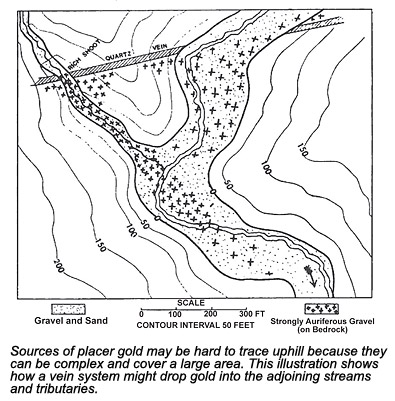Ask The Experts
Free / Ask The Experts
Ask the Experts—How do you determine how far a piece of gold has traveled in a stream?
December 2011 by Chris
Q: In your book you depict crystallized gold in the section on placer mining and state that gold of this type has not traveled far from its source. I am getting such gold from the local stream where I prospect in sizes of about 2/10ths of a gram. They display nice overlapping triangular crystals with little or no etching or roundness. Is there any way to determine how far a piece has traveled in a stream before it deposits?
Upstream I have found some recent rock slides. Incidentally, I found both locations by examining concentrates with a short wave UV (Ultraviolet) light to determine if scheelite is present in quantity since it has a higher specific gravity than black sand. Any estimates would be appreciated.
Sincerely, Byron
A: That’s a great idea and I wish there was some way to use a formula to estimate how far a nugget has traveled. While sharp-edged, angular nuggets are the hallmark of gold that has not traveled far, there is no way to look at a nugget and say that it’s traveled a certain distance from its source. It’s not even possible to make an estimate.
The problem is that there are many variables that determine how much wear a nugget receives. How would one measure the wear on a nugget not actually knowing exactly what it looked like when it came out of the  ground? In fact, some nuggets are a bit rounded when they come out of the ground. This occurs from chemical etching at the time they are formed. In steep grades, gold can be blown right down out of the hills and receive very little wear. Smaller pieces can get washed downstream faster and receive little contact or wear as compared to larger pieces that may move more slowly through the system.
ground? In fact, some nuggets are a bit rounded when they come out of the ground. This occurs from chemical etching at the time they are formed. In steep grades, gold can be blown right down out of the hills and receive very little wear. Smaller pieces can get washed downstream faster and receive little contact or wear as compared to larger pieces that may move more slowly through the system.
We are left with the tried and true methods used by the old timers to trace gold from a stream to its source. Work your way upstream, panning until you no longer find the triangular gold crystals you mentioned, and then look upslope on both sides of the stream. It should be coming from one side or the other. If there is a tributary that comes in at that point, you will need to work up the tributary to see where the gold ends. From the point where the crystalline gold disappears, work your way uphill, sampling the soil with your pan as you go. The source may not be a simple point, as many gold sources are along a fault, rock contact or vein system. 
© ICMJ's Prospecting and Mining Journal, CMJ Inc.